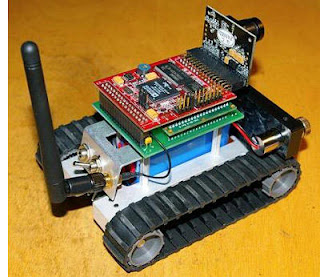Project center in rajapalayam - EDOT Technologies
A. Server room monitoring system (use case 1)
The prototype was designed to monitor at least
two key temperatures, humidity and a flood sensor
in order to detect malfunctioning of the cooling
system in a computer room with servers running
24/7. The hardware prototype assembled with basic
hardware components contains a Base module, a
Power module, and a Core module with attached
temperature tags, a humidity tag and a flood sensor
connected via the Sensor module to Core module.
The BigClown prototype was connected to a
Raspberry PI that simulates a small communication
server and acts as a microcomputer to process and
store data. Influx (DB) and Grafana (Dashboard)
with its dependencies were installed to retrieve and
display data from the BigClown platform.
Additionally, we have installed the BigClown USB
dongle to act as a MQTT gateway for radio devices
on the Raspberry PI. This allows the implementation
of a standalone wireless solution. Figure 6 shows a
fully assembled wireless device with battery
module, temperature tags, humidity tag and flood
detector (right of the figure), and the wireless
gateway module connected to Raspberry Pi server
with an additional USB dongle for RF
communication (left of the figure).
 |
| Add caption |
Since the BigClown platform works together
with a Raspberry PI that uses the Debian OS
(Linux), we have access to multiple software
solutions to save and track the data. Influx Database
has been chosen for storing data, as a real-time
database that is designed for monitoring and
controlling sensors and devices and for storing data
metrics and events, which suits our application
goals.
B. Seat occupancy monitoring in meeting rooms
(use case 2)
https://edottechnologies.in/ This project is aimed at monitoring meeting room
occupancy and evaluation of room usage as
compared to reservations. Additional technical
requirements were specified as follows:
• The device should use RF-module for
communication. Even though Bluetooth and
Wi-Fi are very popular ways to connect
devices, we have avoided those protocols for
the sake of reducing power consumption and
improving connectivity distance.
• Sensors will be heavily used (chairs are used
daily for about 3-5 hours), so that avoiding
mechanical and direct contact sensor
components will reduce the risk of mechanical
failure or damage of components.
• Sensor unit should monitor each chair or seat
to increase accuracy of the collected data.
Many different sensors were considered and
evaluated, including temperature sensors, strain
gauge sensors, IR sensors, ultrasonic sensors, PIR
sensors, lux sensors, piezoelectric sensors,
capacitive sensors, etc. The BigClown platform was
selected due to its flexibility and also because of the
availability of a temperature module, PIR module
and a lux meter module in the kit; most of the
sensors provided traceable signals. The Figure 8
shows an example of PIR sensor data within a short
sitting session, illustrating that even small movements of a person sitting on the chair are
detected.
The PIR sensor solution seemed to be optimal
when compared to other sensors we evaluated.
Unfortunately, the overall cost of this solution was
not acceptable when using a separate sensor for each
seating place (chair). The estimated price for several
meeting rooms with an average number up to 10
chairs per room became too high.
We have decided to implement an inexpensive
solution using a custom made capacitive sensor
modules. Capacitance sensing is a technology based
on capacitive coupling that can detect and measure
anything that is conductive or has a dielectric
difference from air. This technology is commonly
used in touch screens and track pads.
1) Capacitive sensor module
Capacitive sensor electrical signal goes through
high-value resistor; the output of the resistor is
connected to input pin of the MCU (Microcontroller
unit). There is a “sensing area” connected to the
output pin of the resistor. This area influences the
time required to change input pin state of the MCU.
Interestingly, the area doesn’t require direct contact
with source of the capacitance (i.e. human body) [9].
Step by step assembly procedure is outlined in the
Figures 9 and 10.
Project Center in Rajapalayam
Project Center in Rajapalayam
2) Practical implementation
A custom made capacitive sensing module was
placed on top of BigClown modules in similar
manner to other BigClown native modules. The seat
cover contains embedded sensing area. It is
important for monitoring to keep the input pin
discharged after the sensing is done to avoid the
preceding values influencing later measurements,
i.e. avoiding a situation where the sensor is
continuously sending high signal values indicating
seat occupancy. Sensing algorithm has to follow
alternating switching of input and output pin values
(LOW and HIGH). The algorithm includes delays
needed to fully discharge the input pin and
measuring time needed for signal to change the state
on receive pin to HIGH.
All values are displayed in arbitrary units that
indicate time needed to receive pin on MCU to
change its state. As shown in Figure 11, around
15:51 the sensor signals rises from ~600 arbitrary
units to over 5000 arbitrary units. It clearly indicates
the moment when person sat down on the seat. At
around 16:00 the person got up, resulting in a sharp
signal fall shown on the chart, with signal returning
to the baseline.
We can clearly identify the time when a person
sits down on the chair (value rises) and when a
person leaves the chair (value drops back to the
baseline). On top of that we have reduced sensor
price to a negligible amount and have improved
strength and reliability. The installation within the
seat cover allows testing of the solution with up to
32 channels prior to the eventual incorporation of
the setup into chairs.
No comments:
Post a Comment